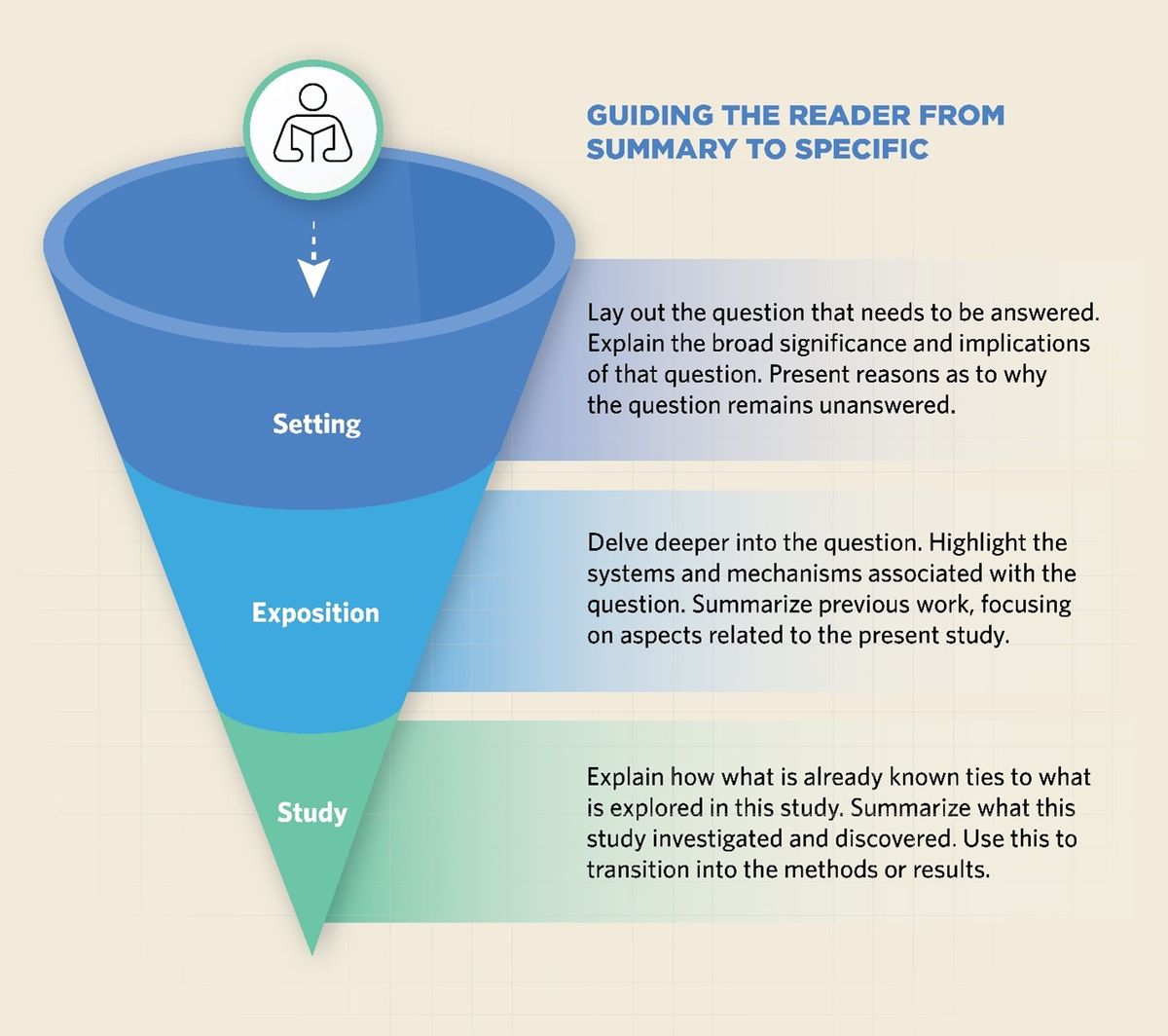
First impressions are important. Scientists need to make their work stand out among a sea of others. However, many mistakenly believe that first impressions are formed based only on titles and abstracts. In actuality, the introduction section is critical to making a real impression on the audience. The introduction is where authors outline their research topic and describe their study. It is where they provide background information and showcase their writing and argumentation styles. For these reasons, the introduction engages the audience in a deeper way than the formalities and rigidities of the title and abstract can afford. To use a fishing analogy: if the title and the abstract serve as the hook and the bait, then the introduction is the process of actually reeling the fish into the boat.
Good Introductions Are Important Guides
In contrast to the constraints placed on the title and abstract, the introduction is the first real opportunity for the scientist to engage with their audience and showcase and convey their passions and motivations for the study in question. This opportunity is somewhat of a double-edged sword. Study authors inevitably have a treasure trove of knowledge and expertise when it comes to their projects and their fields. However, they must remember that the audience does not necessarily have this background information—and that they are only engaging with their audience for a finite amount of time. Despite the urge to excitedly write about all of the different aspects and intricacies of the project, it is very important that authors keep their introductions simple and well organized.
Therefore, the introduction should move from broad scopes to narrow focuses as the audience reads further. The author should direct the reader along this journey, focusing on topics with direct relevance to what was investigated in the study. A broad fact introduced early on should be linked or paired with a more specific fact along the same lines of thought, eventually culminating in how this information led to the motivation behind the study itself. It is vital to not go off on tangents or talk about things that are too esoteric. A confused audience is an audience that tends not to read further.
Applying Common Principles Across Well-Known and Niche Subjects
Writers can apply these principles in more specialized manuscripts focusing on a single entity rather than a well-known pathology. Consider the following example from a manuscript by cell biologist Luis R. Cruz-Vera’s research team from the University of Alabama in Huntsville, published in the Journal of Biological Chemistry.1
Here, they divide the opening paragraph of their introduction into four distinct sections. First, they explain what ribosome arresting peptides (RAPs) are and what they do.
Ribosome arresting peptides (RAPs) are nascent polypeptides that act in cis on the translating ribosome to control the expression of genes by inducing ribosome arrest during translation elongation or termination. RAPs commonly sense external forces or low molecular weight compounds in the environment that spatially and temporally contribute to the expression of genes.
Then they introduce the two different types of RAPs.
RAPs such as SecM that sense external forces on the ribosome are typically large, because these nascent peptides have a domain that functions outside of the ribosome. In contrast, those that sense small molecules inside of the ribosome, such as TnaC are smaller.
They describe how each type works via a different mechanism.
Typically, larger RAPs interact with cellular factors that can control their capacity for arresting ribosomes. Because of their size and proximity to ribosomal components, large RAPs clearly show two structural domains, a sensor domain and an arresting domain. At the moment of the arrest for the large RAPs, the sensor domain is located outside the ribosome exit tunnel, whereas the arresting domain remains inside the tunnel. The short RAPs currently characterized interact with the compounds that they sense by using the ribosome exit tunnel as a binding surface. For these short RAPs, it has been determined that conserved amino acid residues are necessary to induce arrest by either directly binding the effector molecule or by acting at the peptidyl-transferase center (PTC) during ribosome arrest.
And finally, they conclude by highlighting a knowledge gap in how small RAPs operate versus what is already known about large RAPs.
However, because the size of short RAPs ranges from only a few to a couple of dozen amino acids, as in the case of TnaC, it has remained unclear whether short RAPs are constituted by the two independent sensor and stalling domains, as it has been observed with larger RAPs.
In this way, the authors make a natural progression from “why this topic is important” to “what is known about this topic,” setting the stage for “what is unknown about this topic and why it should be studied.”
Gradually Moving from Broad to Narrow

These principles can be further transferred towards the introductory section as a whole. The first paragraph should serve as an introduction to the field and the topic. The middle paragraph(s) provide exposition and detail regarding what is known and unknown, and what has already been done and still remains to do, and the final paragraph outlines the study and its principle findings, providing a transition into either the materials and methods or the results section.
For example, this work by radiation oncologist Eric Deutsch’s group at Université Paris-Saclay, published in PLoS One,2 opens by succinctly explaining a scientific problem: “the threat of extensive dispersion of radioactive isotopes within populated areas that would have an unfortunate effect on human health has increased drastically.” It then offers the call to action necessitated by this problem: “the development of a decorporating agent capable of effectively mitigating the effects of a wide range of isotopes is critical.”
In the next two paragraphs, the study authors provide information on how and why dispersion of radioactive isotopes are a problem—“the FDA has approved only three compounds (only one of which is used as a preventative therapy) for the treatment of exposure to specific radioactive elements”—and highlights the strengths and weaknesses of what is currently available. They then introduce the focal point of their own work, chitosan@DOTAGA, within this context, explaining its potential as a solution to the problem they previously introduced: “After oral administration to rodents over several days, no signs of acute or chronic toxicity were observed, and DOTAGA did not enter the blood stream and was fully eliminated from the gastrointestinal tract within 24 hours of administration.”
Finally, the introduction concludes by listing the study objective—“explore the potential of this polymer for use in the decorporation of a wide range of radioactive isotopes”—and the motivations and rationale behind the study objective—“there are no suitable countermeasures available for uranium poisoning. […] This innovative approach aims to directly chelate the radioactive cations, specifically uranium, within the gastrointestinal tract prior to their systemic absorption, which ensures their prompt elimination and mitigation of the associated toxicities.”
The Introduction Engages with the Reader
The introduction section is often overlooked in favor of the title and the abstract, but it serves two important functions. First, it gives the audience all of the information that it needs to contextualize the yet-to-be-presented data within the context of the problem that needs to be solved or the scientific question that needs to be addressed. Second, and more importantly, it justifies the importance of the study, of its initiative, rationale, and purpose. The introduction is the author’s best—and arguably only real—opportunity to convince the audience that their study is worth reading.
Looking for more information on scientific writing? Check out The Scientist’s TS SciComm section. Looking for some help putting together a manuscript, a figure, a poster, or anything else? The Scientist’s Scientific Services may have the professional help that you need.
- Judd HNG, et al. Functional domains of a ribosome arresting peptide are affected by surrounding nonconserved residues. J Biol Chem. 2024;300(3):105780.
- Durand A, et al. Enhancing radioprotection: A chitosan-based chelating polymer is a versatile radioprotective agent for prophylactic and therapeutic interventions against radionuclide contamination. PLoS One. 2024;19(4):e0292414.
